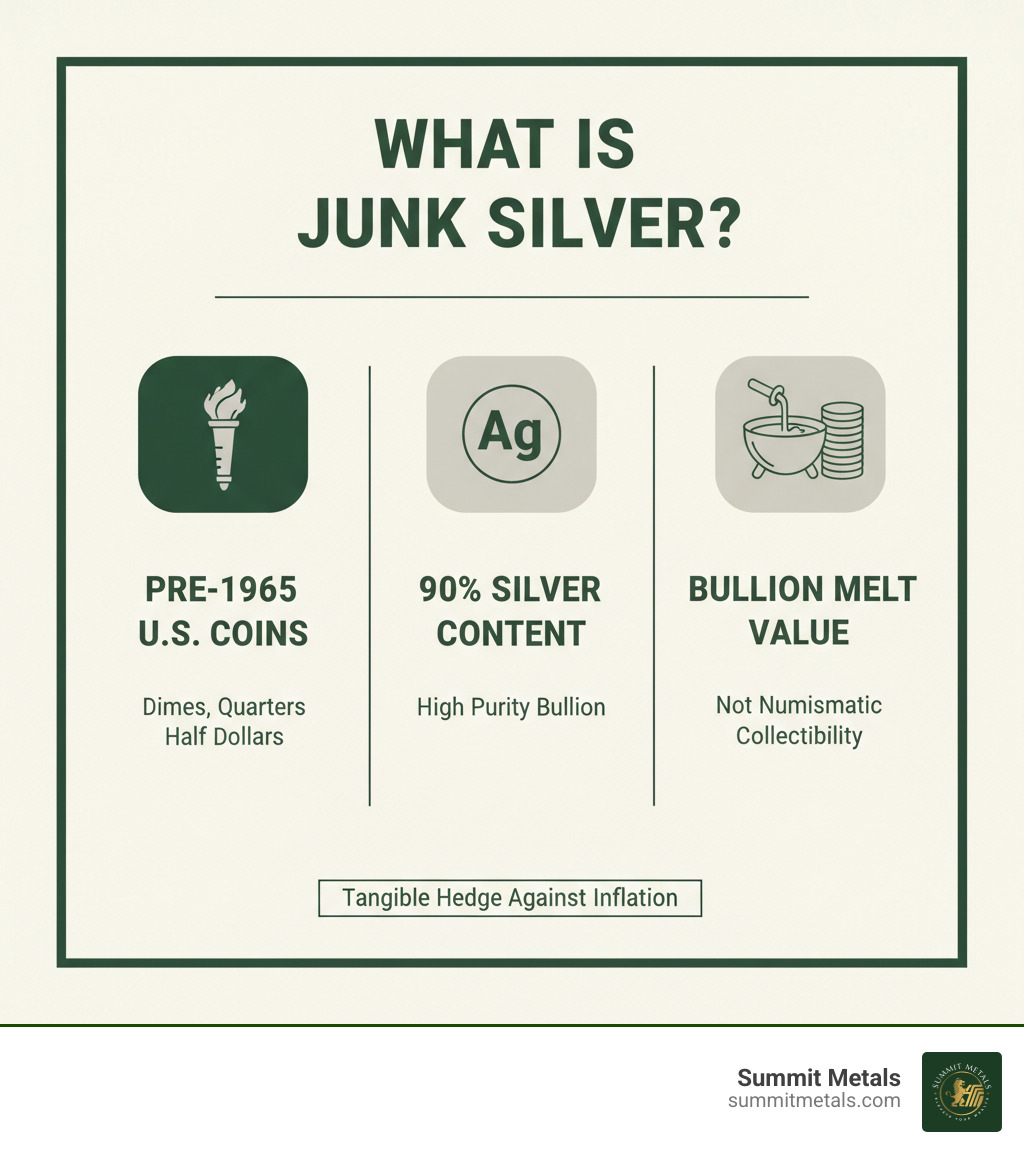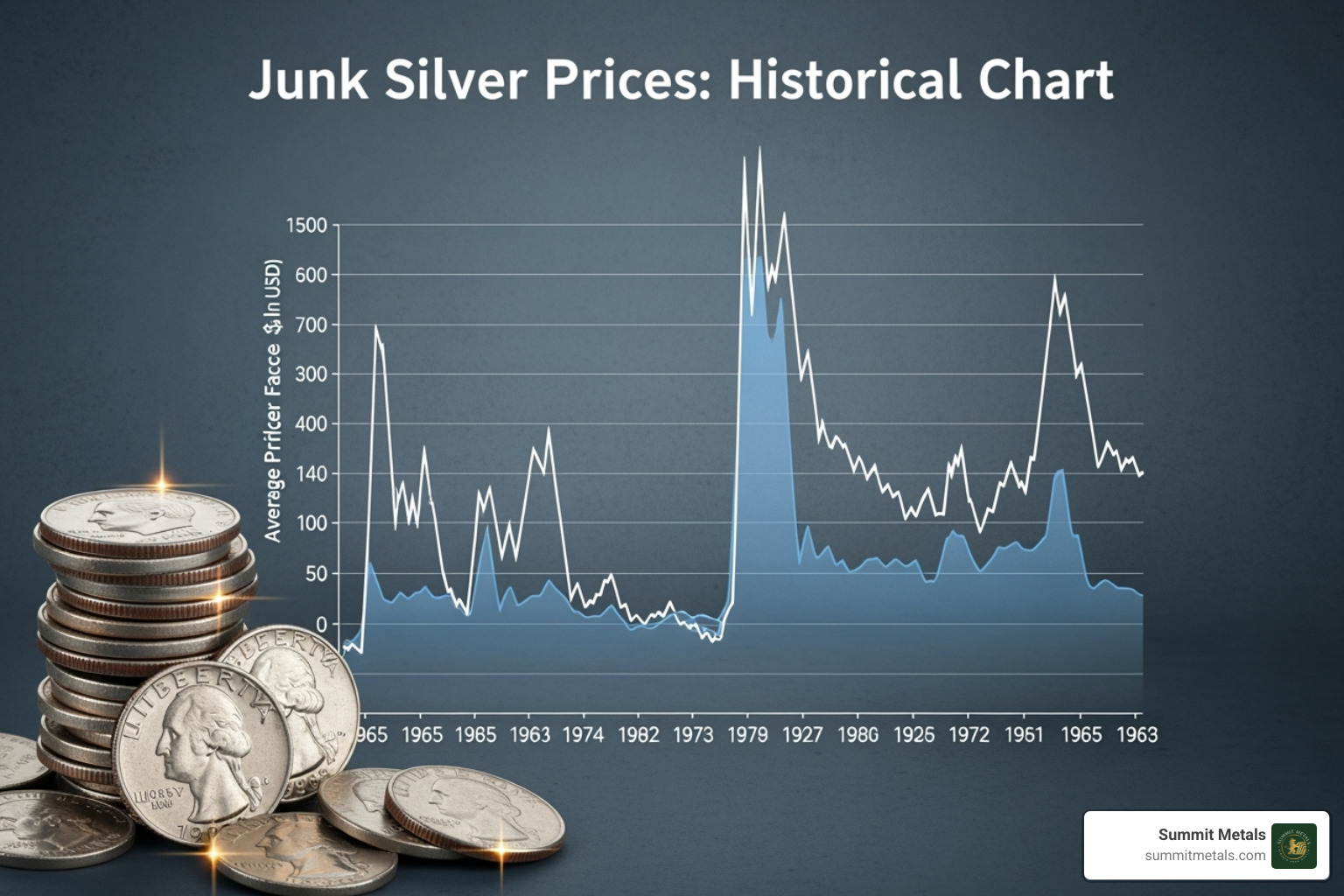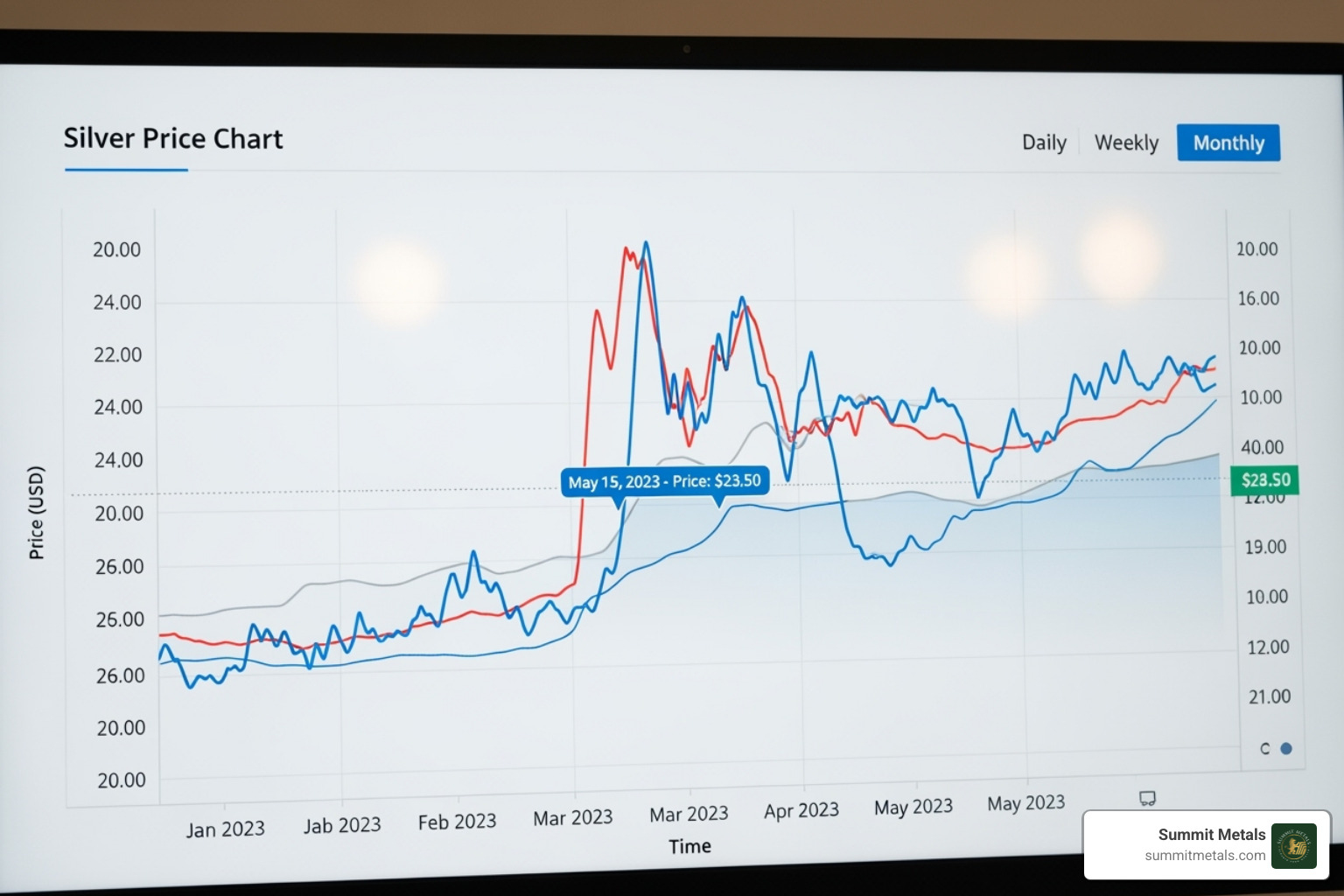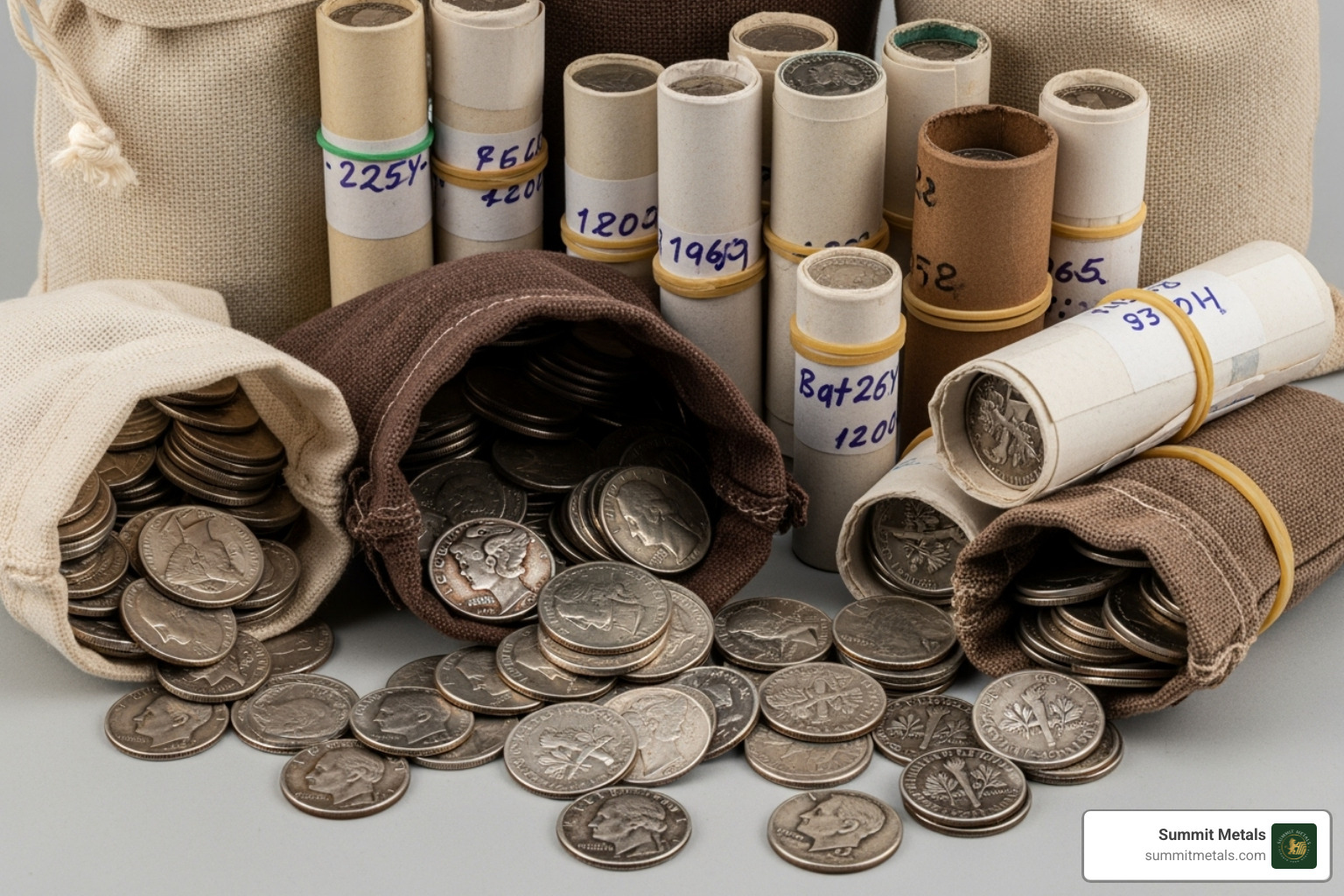Why Understanding Junk Silver Price Charts Matters for Your Portfolio
A junk silver prices chart reveals the value of pre-1965 U.S. coins containing 90% silver. These dimes, quarters, and half dollars are priced on their silver melt value, not collectibility, making them a popular choice for affordable precious metals exposure.
Key indicators to track include:
- Current silver spot price: The base for all value calculations.
- Premium over melt value: The cost above the spot price.
- Face value multiplier: How many times face value the coin is worth.
- Historical price ranges: Provides context for current prices.
The term "junk silver" simply means these coins are valued for their bullion content over numismatic rarity. Containing 0.715 troy ounces of pure silver per dollar of face value, they offer a tangible hedge against inflation. Unlike modern silver bars, junk silver coins are instantly recognizable as former U.S. currency, making them highly liquid and divisible.
I'm Eric Roach, an investment advisor with a decade of experience in precious metals. I've seen how tracking junk silver prices chart patterns helps build defensive portfolios. These coins consistently perform well during economic volatility, making them essential for diversification.

What is Junk Silver and Why is it a Popular Investment?
The term "junk silver" refers to pre-1965 U.S. dimes, quarters, and half dollars containing 90% silver content. The "junk" label simply means they are valued for their bullion content rather than any collectible or numismatic appeal. It's all about the metal, not the rarity.

Junk silver is a popular investment for several practical reasons:
- Divisibility: Unlike a one-ounce silver bar, junk silver comes in small, spendable denominations, making it easy to liquidate small amounts.
- Recognizability: These coins circulated for decades. Their familiarity creates instant trust and liquidity, making transactions simple.
- Hedge Against Inflation: As the dollar's purchasing power falls, silver's intrinsic value tends to rise, acting as a financial insurance policy.
You can start small and build your position over time. Consider an Autoinvest program with Summit Metals to dollar-cost average into junk silver, smoothing out price fluctuations while steadily building your holdings.
Common Types of U.S. Junk Silver
90% silver coins were produced by the U.S. Mint before 1965.
- Dimes: Barber (1892-1916), Mercury (1916-1945), and Roosevelt (1946-1964).
- Quarters: Barber (1892-1916), Standing Liberty (1916-1930), and Washington (1932-1964).
- Half Dollars: Barber (1892-1915), Walking Liberty (1916-1947), Franklin (1948-1963), and the 1964 Kennedy.
- Silver Dollars: Morgan (1878-1921) and Peace (1921-1935) dollars also contain 90% silver but often carry higher numismatic premiums.
Understanding Different Silver Compositions
Not all old U.S. coins have the same silver content.
- 90% Silver: The standard for junk silver, containing 0.715 troy ounces of pure silver per dollar of face value. This makes tracking value with a junk silver prices chart straightforward.
- 40% Silver: Kennedy half dollars from 1965-1970 contain this reduced silver content. They hold intrinsic value and often trade at lower premiums.
- 35% Silver: "War Nickels" (1942-1945 Jefferson nickels) contain silver to conserve nickel for the war effort. Look for the large mint mark (P, D, or S) above Monticello on the reverse.
Understanding the difference between melt value and numismatic value is crucial. While most junk silver is valued for its metal, always check for rare dates or mint marks.
The Ultimate Junk Silver Prices Chart and How to Read It
Reading a junk silver prices chart is easier than it looks and is key to making smart investment decisions. Silver's spot price is the global benchmark for one troy ounce of pure silver and the foundation for your junk silver's value. However, you'll rarely trade at the exact spot price.
Premiums are the extra cost above spot that covers refining, distribution, and dealer overhead. For junk silver, premiums fluctuate based on demand and inventory. Live silver price data updates frequently, while historical data reveals long-term patterns. You'll also see a bid price (what dealers pay) and an ask price (what they sell for). The gap between them is the bid-ask spread.
If you prefer not to time the market, set up Summit Metals Autoinvest to dollar-cost average automatically—buy every month like a 401k and smooth out volatility.

Understanding the Live Junk Silver Prices Chart
A live junk silver prices chart tells a story about market movement.
- The horizontal line (X-axis) represents time (minutes, hours, or years).
- The vertical line (Y-axis) displays the price per troy ounce in U.S. dollars.
Line charts connect closing prices to show trends, while candlestick charts offer more detail, showing the open, close, high, and low prices for a period. Green candles indicate a price increase, while red candles show a drop. High trading volume shown at the bottom can signal a significant price move. For reliable data, use resources like the LBMA Precious Metal Prices - Silver.
How to Calculate the Melt Value of Your Junk Silver
Figuring out your junk silver's worth is simple. You need the coin's face value, the silver content multiplier, and the current spot price. For 90% U.S. junk silver, the key number is 0.715 troy ounces of pure silver per dollar of face value.
The formula is: Melt Value = (Total Face Value / $1.00) × 0.715 × Current Silver Spot Price
For example, with $25 face value in old quarters and a silver spot price of $31.26 per ounce: ($25 / $1.00) × 0.715 × $31.26 = $559.03
That $25 in quarters is worth over $550 in silver. You can also reference official composition details via the U.S. Mint coin specifications to confirm metal content before calculating melt value. Tracking the junk silver prices chart helps you monitor these values in real time.
Factors and Trends Influencing Junk Silver Prices
The junk silver prices chart moves in response to multiple economic forces. The silver spot price is the primary driver, influenced by global supply and demand.
- Supply comes from mining, recycling, and government sales. Disruptions can tighten supply and raise prices.
- Demand is split between industrial applications (solar panels, EVs, electronics) and investment demand. Economic uncertainty often boosts investment demand.
Economic uncertainty and inflation are major catalysts for precious metals. When confidence in paper assets wanes, investors turn to tangible assets like silver. Central bank policies, particularly interest rates, also play a role. Lower rates can weaken the dollar, making silver more attractive to international buyers, a trend visible on metrics like the Trade-Weighted U.S. Dollar Index (FRED). Finally, dealer premiums reflect real-world costs and demand, affecting the final price you pay.
Historical Price Trends and What They Tell Us
Historical junk silver prices chart data reveals patterns in economic cycles.
- The 1980 silver peak saw prices near $50 per ounce due to an attempt to corner the market, showing silver's potential for explosive moves.
- The 2008 financial crisis highlighted silver's safe-haven appeal, with prices surging as uncertainty rose (see historical data from the LBMA Silver Price series).
- The 2011 price surge to near $50 again reflected fears of currency devaluation.
These events show silver's ability to preserve wealth over the long term, despite short-term volatility. A 1964 quarter's silver content has maintained its purchasing power far better than the dollar itself.
Junk Silver vs. Other Silver Bullion Products
Choosing the right silver product depends on your investment goals. Each type offers different advantages.
| Product | Purity & Guarantee | Premiums | Divisibility | IRA Eligible | Best For |
|---|---|---|---|---|---|
| Junk Silver | 90% Silver, recognizable as former US currency | Low to Moderate | Highest | No | Liquidity, small transactions, bartering |
| American Silver Eagles | .999 Fine, US Gov't guaranteed | Highest | Moderate | Yes | IRA contributions, maximum trust & liquidity |
| Silver Bars | .999+ Fine, refinery guaranteed | Lowest | Lowest | Yes | Accumulating maximum ounces at low cost |
| Canadian Maple Leafs | .9999 Fine, Canadian Gov't guaranteed | Moderate | Moderate | Yes | High purity investment, IRA contributions |
Junk silver's unique position comes from its best divisibility and recognizability. While other products offer higher purity, the practicality of using pre-1965 coins for small-scale transactions is a significant advantage. For investors using a dollar-cost averaging strategy through Summit Metals' Autoinvest program, junk silver provides excellent flexibility for regular, small-scale purchases—set it and forget it, just like a 401k.
Gold Coins vs. Gold Bars (Quick Comparison)
If you're also considering gold, here’s a fast comparison to help you decide:
| Product | Backing & Identity | Premiums | Divisibility & Liquidity | Security Features | Best For |
|---|---|---|---|---|---|
| Gold Coins (e.g., American Gold Eagles/Maple Leafs) | Legal tender with a face value and government-backed designs | Generally higher than bars | High recognizability; easier to sell in smaller units | Legal tender status, well-known anti-counterfeit features, and consistent designs help deter fraud | Portfolio balance, gifting, maximum trust and liquidity |
| Gold Bars (e.g., 1 oz, 10 oz, kilo) | Refinery-backed with assay/serial numbers | Typically lower than coins | Best for stacking ounces; larger bars less divisible | Assay cards and serial numbers; relies on refinery reputation | Lowest cost per ounce, long-term accumulation |
Bottom line: Coins often command slightly higher premiums but offer legal tender status, strong recognizability, and anti-counterfeit features that can reduce fraud risk. Bars minimize premiums and are ideal when your priority is maximizing ounces per dollar.
Strategies for Buying and Selling Junk Silver
Whether you're just starting your precious metals journey or looking to expand your holdings, having a solid strategy for buying and selling junk silver can make all the difference. The key is finding the right balance between timing, pricing, and working with dealers you can trust.
When it comes to reputable dealers, you have two main options: local coin shops and online dealers. Local shops offer the advantage of face-to-face interaction and immediate possession of your coins. However, online dealers like Summit Metals often provide more competitive pricing due to lower overhead costs and bulk purchasing power. We're based in Wyoming and pride ourselves on transparent, real-time pricing that gives you the best value for your investment.
Understanding premiums is crucial to your success. This is the amount above the silver spot price that you'll pay when buying or receive when selling. These premiums fluctuate based on market demand, dealer inventory, and current economic conditions. A junk silver prices chart will show you the underlying silver price, but you'll always need to factor in these premiums for your actual cost.
Timing the market perfectly is nearly impossible, but you can watch for opportunities. When silver prices dip significantly or when premiums are unusually low, it might be a good time to add to your position. Conversely, when premiums spike due to high demand, it could be an opportune moment to sell some of your holdings.

Best Practices for Buying Junk Silver
The most successful junk silver investors follow time-tested strategies that remove emotion from their decisions and focus on long-term wealth preservation.
Dollar-cost averaging is perhaps the most powerful strategy for building your junk silver position. Instead of trying to predict market movements, you invest a fixed amount at regular intervals - maybe $200 every month or $500 every quarter. This approach means you'll automatically buy more silver when prices are low and less when they're high, smoothing out your average cost over time.
At Summit Metals, we make this even easier with our Autoinvest program. Just like contributing to your 401k, you can set up automatic monthly purchases that build your precious metals portfolio without having to think about it. More info about Autopay is available on our website, and it's one of the most popular features among our long-term investors.
Buying during price dips can complement your dollar-cost averaging strategy. When you see significant drops in the junk silver prices chart, consider making an additional purchase beyond your regular investment. These opportunities don't come often, but they can significantly improve your overall cost basis.
Checking for authenticity might seem less critical with junk silver since these are recognizable U.S. coins, but it's still important to buy from trusted sources. Reputable dealers guarantee the authenticity of their products and have the expertise to spot counterfeits.
Bulk purchases often provide better value for your money. Buying junk silver in bags of $100 or $1000 face value typically results in lower premiums per ounce compared to smaller quantities. Our bulk purchasing power at Summit Metals allows us to pass these savings directly to our clients.
Smart Selling and Associated Risks
Knowing when and how to sell your junk silver is just as important as building your position in the first place.
Knowing melt value is your foundation for any selling decision. Before you contact any buyer, calculate the current melt value of your coins using the formula we discussed earlier. This gives you a baseline for negotiations and ensures you're getting a fair offer.
Selling when premiums are high can maximize your returns. During times of high demand or supply shortages, premiums can spike well above normal levels. If you're not planning to hold your silver long-term, these periods present excellent selling opportunities.
However, there are important risks to consider. Price volatility means silver can swing dramatically in short periods. What seems like a good selling price today might look modest next month if prices continue rising. This is why many investors view junk silver as a long-term hold rather than a short-term trading vehicle.
Counterfeit coins are less common in the junk silver market due to the lower individual value of circulated coins, but they do exist. Always work with buyers who can verify authenticity and have established reputations in the precious metals community.
Finding trustworthy buyers is essential for a smooth selling experience. Look for dealers who offer transparent pricing, clear processes, and prompt payment. At Summit Metals, we provide straightforward options for clients who want to sell their precious metals back to us, ensuring the same level of service whether you're buying or selling.
Frequently Asked Questions about Junk Silver Prices
At Summit Metals, we often hear the same questions about junk silver prices chart analysis and investing. Here are answers to the most common ones.
How much silver is in $1 of 90% junk silver coins?
Every $1 of face value in 90% silver coins (ten dimes, four quarters, or two half dollars) contains approximately 0.715 troy ounces of pure silver. This standard multiplier is used across the industry to calculate melt value quickly and accurately.
Is junk silver a good investment for beginners?
Yes. We often recommend it as a starting point. Junk silver's small denominations make it accessible and affordable. Its divisibility allows you to start small and grow your holdings over time. Furthermore, its recognition as former U.S. currency provides an immediate layer of trust that is less intimidating than other bullion products.
Can I put junk silver in a Precious Metals IRA?
Unfortunately, no. Most junk silver does not meet the .999 minimum purity requirement set by the IRS for Precious Metals IRAs. For IRA contributions, you should consider eligible products like American Silver Eagles, Canadian Silver Maple Leafs, or .999+ fine silver bars. This highlights how different silver products serve different investment purposes.
How do Canadian circulated silver coins compare to U.S. junk silver in terms of value and composition?
Canadian circulated silver coins also have intrinsic value, but their silver content is generally lower and varies by era.
- Pre-1920 Canadian coins are 92.5% silver (sterling).
- 1920-1967 Canadian coins are 80% silver.
- Some 1967-1968 coins are only 50% silver.
Because U.S. 90% junk silver contains more silver per dollar of face value (0.715 oz) compared to the most common Canadian 80% junk silver (approx. 0.6 oz), American coins are generally preferred for pure silver content. However, Canadian coins can still be a good value if acquired at the right price.
Chart Your Financial Future with Junk Silver
The junk silver prices chart tells a story of resilience and opportunity. These pre-1965 U.S. coins represent tangible wealth that has been trusted for generations. Each dollar of face value contains a fixed amount of silver—approximately 0.715 troy ounces—a certainty in an uncertain world.
The divisibility of junk silver is remarkable. Unlike large bars, dimes and quarters can be easily portioned for any transaction size. Historically, junk silver has proven to be a reliable inflation hedge, preserving purchasing power when paper currencies falter, as seen during the 2008 financial crisis and other periods of volatility.
At Summit Metals, we are built on transparent pricing and competitive rates. Based in Wyoming and serving clients nationwide, including Salt Lake City, Utah, we know trust is paramount. We provide real-time pricing and authenticate every item we sell.
Starting your journey is simple. Our Autoinvest program lets you dollar-cost average into junk silver, just like a 401k, building your holdings systematically. These coins are more than just silver; they are a reminder of sound money principles, making them instantly liquid.
Ready to add stability to your portfolio? Learn more about Constitutional Silver and find how these time-tested coins can protect your wealth.



